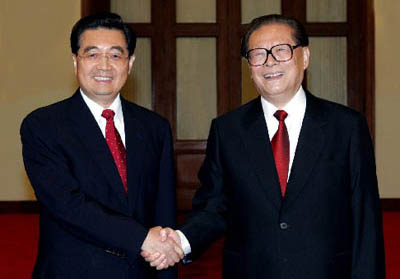There is no sign of a multiparty system emerging in the near future. The Chinese Communist Party will continue to have strict control over the army, media, legal and judicial system. While recognizing all these continuities, several important factors are now influencing change in the conduct of Chinese politics.
One is the emergence of two almost equally powerful coalitions that represent different social and geographical divisions in China. Factional politics have existed in China for a long time, but for the first time we now see a situation in which two factions, or coalitions, share power and influence and they are almost equally powerful in the one political system.
The Populist Coalition is currently led by President Hu Jintao and Premier Wen Jiabao. At the core of this faction are the Tuanpai: those leaders who moved up through the Chinese Communist Youth League (Hu Jintao’s power base). This faction (the Red Team) also includes party functionaries (among them, the new left intellectuals) and rural leaders, especially those from China’s inland provinces (we call them China’s Red States).
The Elitist Coalition includes the ‘princelings’ (children of high ranking officials), the ‘Shanghai Mafia’, entrepreneurs and capitalists, returnee’s (foreign educated Chinese nationals, or what the Chinese call the ‘sea turtles’), and urban leaders from China’s coastal region (China’s Blue Team).
The Populist coalition is more focused on social cohesion – Hu Jintao’s harmonious society – regional development, a people-centred rhetoric, and advocate ‘green GDP’. They are concerned with social factors, migration patterns and the urban poor. In contrast the Elitist coalition, is interested in economic efficiency, coastal development, and less concerned about the environment, emphasising rapid GDP growth. They represent the interests of entrepreneurs and the emerging middle class.
Among the new politburo, there are six members belonging to the 5th, or ‘new’, leadership generation, and equally divided between the two factions. Similarly, of the six secretaries, four are from the new generation: two from each faction. Of the four Vice Premiers, two are from each faction. Of the five State Councillors, one is from the military (which is supposed to be neutral) and each faction has two. The competition between the factions is so intense that they don’t want any person without strong factional ties to enter an important leadership body.
Of the 371 members of the current (17th) Central Committee only about seven per cent were born in the 1960s (the 6th generation) but almost half were born in the 1950s (the 5th generation). The number of Tuanpai increased from 50 in the 16th Central Committee to 86 now (about 23 per cent). The princelings also increased their numbers, but by a smaller margin.
In the Central Committee, while the Populist coalition holds more positions, the Elitists hold more seats in the Politburo. The Populist coalition controls areas such as party organisation, propaganda, united front work, law, party discipline, and provincial leadership, while the Elitist coalition controls the economic administration, foreign trade and finance, foreign affairs, education, science and technology, military affairs and public security.
The background of the new leaders is also changing. The educational background, defined by the highest degree attained by each of eight rising stars in the Politburo is economics, history, management, journalism, an MBA and three with law: none of them have their highest degree in engineering as in the past. This is a substantial change. Many come from an entrepreneurial background, including having been the CEOs of private sector companies.
What does this mean for the rest of the world, especially foreign governments and the international business community?
The bottom line is, it is prudent to have friends in both camps and one should develop strategies and policies that are attractive to both camps. Could the Red and the Blue Teams emerge as contestants in a two or multiple party system? It is possible. In ten or fifteen years, it is unlikely that the Communist Party will dominate as it does today. But a change like this will be complex and, if it is made, has to be made in a way that doesn’t threaten the stability of the country.
Click here to see more China Update posts.
Download the audio of the presentation China’s emerging generation of leaders: trajectory for the future by Ross Garnaut (chair) & Cheng Li.
See the video of Cheng Li’s presentation:


This is a tantalising glimse into the possible future.
The alternative to two factions evolving into competing parties could be yet another purge of one of them?
What are Tuanpai?
I think Tuanpai is the name of the faction that has its leaders come through the Chinese Communist Youth League – I think it actually is the name of the CCYL.
Andrew,
Shiro was mostly right. The full name of the CCYL is Zhōngguó Gòngchǎnzhǔyì Qīngniántuán (中国共产主义青年团). Tuan is the last character and means faction.
The CCYL is abbreviated to Gòngqīngtuán (共青团) where Zhōngguó (China) is dropped, Gòng is the abbreviation for communist, qīng is the abbreviation for youth, and tuán = group.
Pài also forms the second half of the pair of characters that mean political party (Dang’pài), which is usually shortend to Dang.
Tuán’pài translated character at a time would be “group faction”, but its universally recognised as meaning the faction of The Party who made their career through the CCYL.
As for a purge of one or the other, anything is possible, but it seems both factions are very deep and well established. Much deeper than just the standing committee at any rate, so it would have to be a very large purge I would think. I doubt we’ll see an open two party system, but the main benefits of such a system (accountability, political rejuvenation, centrist tendency of policy) can be achieved in multiple ways.
This is a tantalising glimse into the possible future.
The alternative to two factions evolving into competing parties could be yet another purge of one of them?
What are Tuanpai?